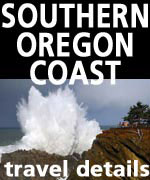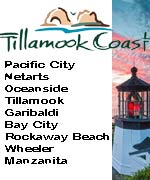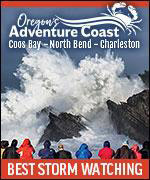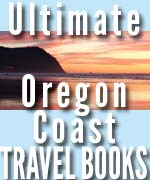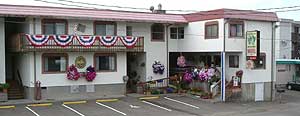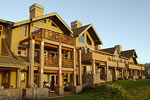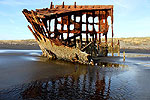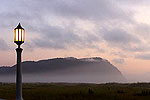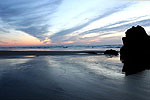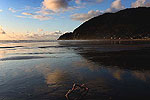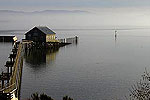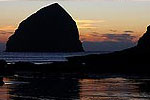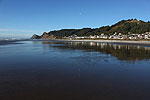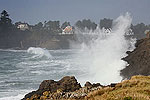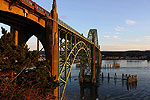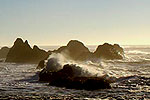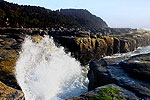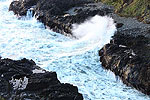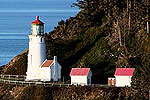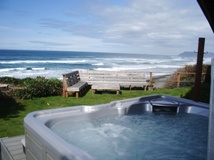 |
Oregon Coast Tips for the Road and the Beach |
|---|
Covering 180 miles of Oregon coast travel: Astoria, Seaside, Cannon Beach, Manzanita, Nehalem, Wheeler, Rockaway, Garibaldi, Tillamook, Oceanside, Pacific City, Lincoln City, Depoe Bay, Newport, Waldport, Yachats & Florence.
07/08/08
Secrets of the Season |
Summer Travel and Beach Tips for Oregon Coast
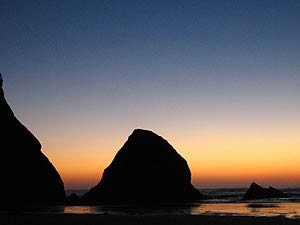 |
| Arch Cape, near Cannon Beach, during an especially balmy sunset |
(Oregon Coast) - It's all fun and games on the Oregon coast until someone gets really wet and cranky, too cold because they didn't bring the right clothes, you didn't think ahead or something annoying like that.
From lodging to staying dry on the beaches, to dressing right for all kinds of weather, you should probably read this whole article before you head to the Oregon coast next time.
The big rule for the coast almost any time of year: take along a change of clothes or two. The weather can go up and down within minutes, which creates some unusual and memorable spectacles - but it’s a pain in the butt if you’re on a long beach walk during a spell of sunny weather and you get soaked by a sudden rainsquall because you didn’t bring your coat. Nasty.
In mid-summer and late summer there are some slightly different rules. Many a coastal jaunt has been ruined by someone in your party who was all dressed down for summer in shorts and a t-shirt when they left the sweltering valley, only to hit the cooled down coast with no jacket or change of clothes at hand. Then they've complained or suffered through their chills the whole time. Make sure you're prepared for drastic changes in weather - especially if you're on the Oregon coast for more than a day trip.
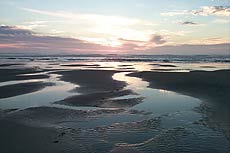 |
| Walking along the beach isn't always a dry endeavor - Tierra Del Mar, near Pacific City |
Or, if you're goofing around the sand and fall in a tide pool or a creek, you’re going to wish you’d brought along an extra pair of pants or something. This happens a lot easier than you think. Make sure you bring a coat if you’re going to wander too far from your car.
And whatever you do, make sure you bring along more than one pair of shoes and socks. It’s way too easy to get these wet – and they usually stay that way for a whole day. You’ll certainly want to wear sandals or flip-flops while bouncing around the sand.
If you're going to explore rocky tidal areas, bring shoes that stick well and don’t slip too easily. It’s likely what you’ll be doing is some kind of climbing, at least in a minor way. Sneakers or hiking shoes with a good grip are best for these areas. Always be careful of extremely slippery areas on the rocks, usually found on green spots near the tide. These green areas should be a red alert for you: it’s extremely treacherous while wet. Falling on your back or head here is especially risky business, especially if you’re close to the water.
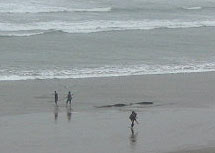 |
| Weather can change abruptly on the coast, from sunny to this kind of overcast (pictured here, Newport) |
The weather can yield all sorts of surprises. July tends to be warmer and more inviting. Things on Oregon's shoreline in August can again be a mixed bag in the weather department - a mish mash of sun, overcast, wind, drizzle and fairly warm temperatures. Although usually it is warmer than the rest of the year. Unlike the spring, conditions aren't puzzling for the tourist with that season's abrupt changes from hour to hour, but the region does have its stark differences during these dog days of summer. You may be running from heatwaves in the valley, but arrive on the coast to find things a little cooler than you anticipated.
The warmest time of the year on the coast is actually the fall months of September and October, when you’ll find the most cloudless skies, the least winds and the highest temperatures in the landscapes as well as in the ocean.
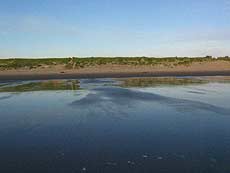 |
| Gearhart in the summer |
The other aspect to look out for in late summer is the
massive crowds, traffic and lodging availability. At this time of year,
everyone has embarked on their vacations, often with a sense of urgency
having come from realizing, "Oops, summer's almost done and we haven't
taken our vacations yet." So mid-week is filled with beachgoers heading
to and from the beach on the highways, creating all sorts of traffic backups
and dangers. Make sure you leave early enough to give yourself plenty
of time to get where you're going so speeding or driving recklessly isn't
a temptation, because there's always a few people who didn't do that,
and you'll have to share the road with them.
It's advisable to leave the coast later in the day, perhaps after sunset,
to find the least traffic - even if nighttime driving isn't as pleasant
as daytime motoring.
Also, lodging availability, even during the mid-week is a problem in the summer. Countless motels are booked up even during the middle of the week at this time frantic time of year. Not to mention, finding a place to stay on weekends is actually rare. So make sure you reserve your's ahead of time. Luckily, BeachConnection.net provides a service each Thursday morning with lodging availability for the weekend and even during the weekend. See the news link for this.
 |
| Be a little more exact when inquiring about lodging (pictured here, lodgings in Seaside) |
Finally, there’s one major tip we can impart that is such a touchy subject among lodgings, but they’re shy to discuss it to customers.
When it comes to inquiring about lodging reservations, one thing the tourism officials and lodging folks don’t tell you is that it’s so important to state how many people will be staying and how many nights along with what dates you were asking about. Innkeepers find nothing more annoying than those that call up and ask, “How much is a room?” That’s way too much of a blanket question.
All that depends on what dates you're thinking about (midweek or weekend, and what time of year) and how many people will be staying (they charge per person in most cases). Asking the way too simplistic question of "how much are the room rates?" is equal to asking a grocer who carries a ton of different produce, "how much are your vegetables?"
It helps to be a little more exact. There's a wide range of things each hotelier offers, and it will make your exchange with them a lot less confusing.
 |
|
Tradewinds Motel, Rockaway Beach. All rooms are immaculate and have TV’s, VCR’s and in-room phones w/ data ports. Oceanfronts have queen bed, a double hide-a-bed, kitchen, cozy firelog fireplace and private deck. Both types sleep up to four people. Others are appointed for a two-person romantic getaway, yet still perfect for those on a budget. Elaborate oceanfront Jacuzzi suite has two bedrooms, kitchen, double hide-a-bed, fireplace and private deck, sleeping as many as six. For family reunions or large gatherings such as weddings, some rooms can connect to create two-room and three-room suites. Some rooms pet friendly. 523 N. Pacific St., Rockaway Beach. (503) 355-2112 - 1-800-824-0938. www.tradewinds-motel.com |
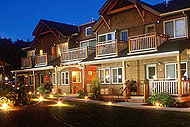 Inn
at Cannon Beach. Beautifully wooded natural setting at quiet south
end of Cannon Beach. Great during winter storms with a new book by
the fireplace – or when the sun is out for family fun and beach
strolling. Handsome beach cottage-style architecture. Lush flowering
gardens and naturalized courtyard pond. Warm, inviting guest rooms.
Continental buffet breakfast. Warm Cookies. Family and Pet Friendly.
Welcome gifts. Smoke-free. Complimentary Wireless Connectivity. Wine
and book signing events. 800-321-6304 or 503-436-9085. Hemlock At
Surfcrest, Cannon Beach, Oregon. www.atcannonbeach.com. Inn
at Cannon Beach. Beautifully wooded natural setting at quiet south
end of Cannon Beach. Great during winter storms with a new book by
the fireplace – or when the sun is out for family fun and beach
strolling. Handsome beach cottage-style architecture. Lush flowering
gardens and naturalized courtyard pond. Warm, inviting guest rooms.
Continental buffet breakfast. Warm Cookies. Family and Pet Friendly.
Welcome gifts. Smoke-free. Complimentary Wireless Connectivity. Wine
and book signing events. 800-321-6304 or 503-436-9085. Hemlock At
Surfcrest, Cannon Beach, Oregon. www.atcannonbeach.com. |
|
The Ocean Lodge. There will not be another property built like this in Cannon Beach in our lifetimes. Rare, premiere ocean front location; handsome, dramatic architecture and tasteful, fun (nostalgic) beach interiors. Overlooks Haystack Rock. 100 percent smoke free. Imaginative special occasion packages. Massive wood burning lobby fireplace. Library w/ fireplace, stocked with impressive book collection. Pet and family friendly. Lavish continental buffet breakfast. In-room fireplaces, mini-kitchens. Jacuzzi tubs in select rooms. DVD players, complimentary movies. Morning paper. Warm cookies. 888-777-4047. 503-436-2241. 2864 Pacific Street. Cannon Beach, Oregon. www.theoceanlodge.com |
RELATED STORIES
Click here for video of Dec. storm aftermath
Oregon Coast Best of Awards for the Year And the winners are: best of Oregon coast restaurants, lodgings, science, odd events in nature and stunning moments for 2007
Watching Transformations of Oregon Coast Beaches Seasons change and so do beaches, revealing different sides and a variety of eye-popping sights
Staggeringly Cool Ideas for Oregon Coast Romance Be it the season of Valentine's or be it any time of the year, Oregon's coastline has essentially cornered the market for cuddle-inducing possibilities and gushy activities for the hand-holding set
Day or Night Mysteries and Merriment on Oregon Coast It's more than just nightlife that comes to life, but the beaches offer major opportunities
Oregon Coast Travel Site Goes Wireless Provides Lodging Reports - Oregon Coast Beach Connection now has mobile lodging and dining listings, along with weekly lodging availability reports
|
Arch
Cape Property Services.
Dozens of homes in that dreamy,
rugged stretch between Cannon Beach and Manzanita known as Arch
Cape. Oceanfront and ocean view , or just a short walk from the
sea. |









